There are almost 10,000 different species of birds in the world, showcasing an incredible diversity in size, color, and behavior. When we talk about size among birds, it can be quite ambiguous. Do we measure size by length, weight, or wingspan? For flying birds, wingspan seems to be the most relevant measurement, reflecting how much space they command in the air.
This article will explore the largest flying birds by wingspan, while also acknowledging some of the heaviest contenders. We’ll delve into the impressive dimensions of these avian giants, considering not just wingspan, but also weight and overall characteristics to present a comprehensive view.
It’s worth noting that some bird weights are estimates based on various reports, while others are well-documented. To keep this list diverse and engaging, we’ve intentionally excluded very similar species to avoid repetition among vultures, pelicans, and albatrosses that might closely resemble each other in size.
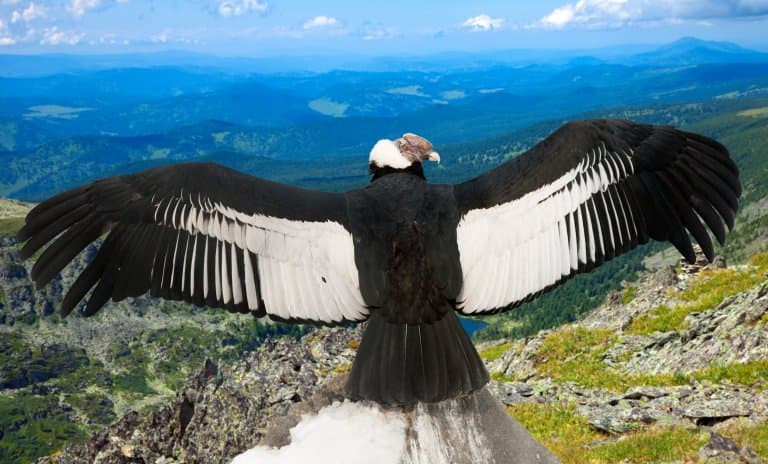 Andean Condor Wingspan: One of The Largest Flying Birds in The World
Andean Condor Wingspan: One of The Largest Flying Birds in The World
Here’s our countdown of the top ten biggest animals that grace the skies, ranked by wingspan, weight, and overall diversity to keep things interesting.
10. Blakiston’s Fish Owl (Wingspan: 1.8 m / 6 ft)
Weight: 4.6 kg / 10 lb
The Blakiston’s Fish Owl is a truly remarkable and rare species of eagle owl hailing from East Asia and Russia. It often competes with its close relative, the Eurasian eagle owl, for the title of the owl with the longest wingspan. Both species can reach wingspans of around 1.8 meters (6 feet) and slightly beyond, making them giants among owls.
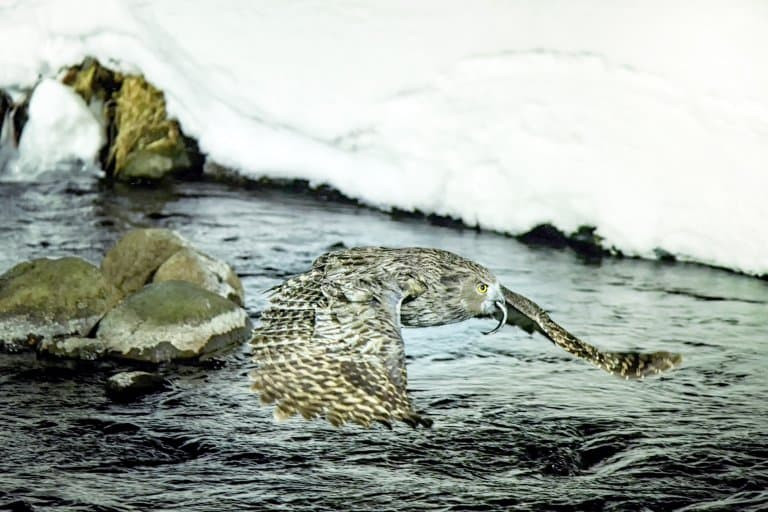 Blakiston’s Eagle Owl: A Rare and Large Owl Species
Blakiston’s Eagle Owl: A Rare and Large Owl Species
While the Eurasian eagle owl might occasionally claim the absolute record wingspan, the Blakiston’s Fish Owl boasts a larger average wingspan. Given its smaller population size and conservation status, the Blakiston’s Fish Owl rightfully earns its place on this list as one of the biggest flying birds. [1](#easy-footnote-bottom-1-8975 “Nyanasengeran Movin et al. (2022), “Using bioacoustic tools to clarify species delimitation within the Blakiston’s Fish Owl (Bubo blakistoni) complex“, Avian Research.”)
9. Dalmatian Pelican (Wingspan: 1.9 m / 6.2 ft)
Weight: 15 kg / 33 lb
The Dalmatian Pelican stands out as the largest pelican species and one of the biggest birds overall. With an impressive wingspan nearing two meters, it dwarfs its canine namesake in size. These pelicans are not known for their elegance in flight, but rather for their sheer size and presence.
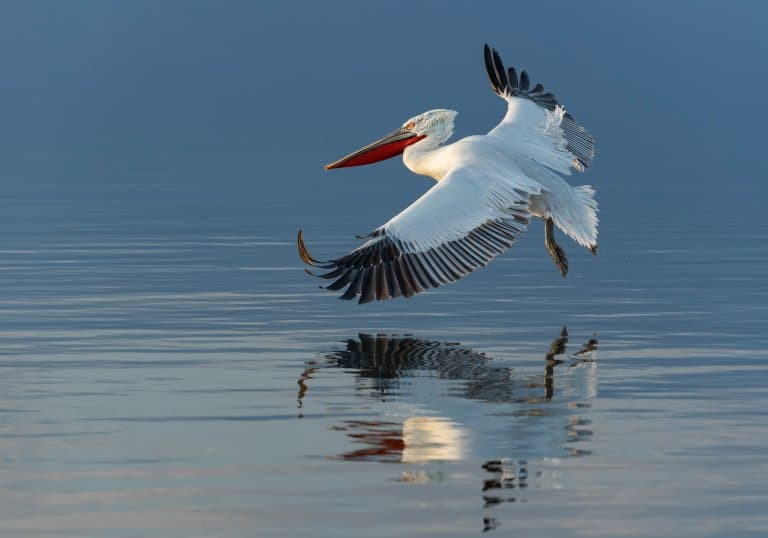 Dalmatian Pelican: The Biggest Pelican Species
Dalmatian Pelican: The Biggest Pelican Species
Dalmatian Pelicans can weigh up to 15 kg (33 lbs), making them one of the heaviest flying birds you might encounter. There have been some exaggerated claims regarding their wingspan, with some suggesting it rivals the largest bird on this list. However, these claims lack solid evidence. While the average wingspan is recorded at 1.9 meters, some reports cite measurements up to 2.8 meters, solidifying its status as a truly large bird in the sky. The Great White Pelican is a close competitor, but on average, the Dalmatian Pelican is considered the larger species. [2](#easy-footnote-bottom-2-8975 “Erin L.R. Simons (2010), “Forelimb skeletal morphology and flight mode evolution in pelecaniform birds“, Zoology.”)
8. Secretarybird (Wingspan: 2.1 m / 6.9 ft)
Weight: 4.27 kg / 9.4 lb
The Secretarybird is a truly unique avian species that almost seems like it belongs in a prehistoric era. It’s as close to a living dinosaur as you can get! Standing tall at up to 1.3 meters (4.3 feet), it’s not just its wingspan that impresses, but its overall stature.
 Secretarybird Flying: A Tall and Unique Bird Species
Secretarybird Flying: A Tall and Unique Bird Species
Despite its considerable size and weight, the Secretarybird is capable of flight, though its morphology isn’t ideally suited for sustained aerial activity. It primarily relies on wind currents for lift and tends to fly in short bursts. This bird spends most of its time on the ground, using its long legs to run and hunt prey in grasslands, showcasing a fascinating blend of terrestrial and aerial capabilities. [3](#easy-footnote-bottom-3-8975 “Steven J Portugal (2022), “Secretary Birds“, Current Biology Magazine.”)
7. Steller’s Sea Eagle (Wingspan: 2.3 m+ / 7.5 ft)
Weight: 10 kg / 22 lb
As we enter the realm of eagles, we encounter a lot of conflicting information, especially when discussing size. Eagles are revered birds, often adopted as symbols of power and national pride by various cultures and nations throughout history. This admiration sometimes leads to a bit of “eagle rivalry” when it comes to claiming the title of the largest.
 Steller’s Sea Eagle: A Heavy and Impressive Eagle
Steller’s Sea Eagle: A Heavy and Impressive Eagle
Several eagle species vie for the title of “biggest,” including the Steller’s Sea Eagle (representing Russia), the Harpy Eagle (from Central and South America), the Philippine Eagle, and the Bald and Golden Eagles (often associated with the USA). Each of these contenders has been credited with wingspans exceeding 2.4 meters (8 feet), but verifiable measurements are often elusive. We’ve highlighted the Steller’s Sea Eagle due to its consistent recognition as the heaviest eagle in the world, giving it an edge in this size-focused list. The Eagle Watchers: Observing and Conserving Raptors around the World“, Cornell University Press.”>4
6. Trumpeter Swan (Wingspan: 2.4 m / 7.9 ft)
Weight: 15 kg / 33 lb
We are now entering the heavyweight category of large flying birds. The Trumpeter Swan, the largest waterfowl species in North America, is indeed heavier than most birds on this list. These majestic birds are widespread across North America and are known for their impressive size and loud calls, distinguishing them from their slightly smaller and quieter European swan relatives.
 Trumpeter Swan: The Largest Waterfowl Species
Trumpeter Swan: The Largest Waterfowl Species
The sheer size of adult Trumpeter Swans provides them with a degree of natural protection. Apart from human hunters, they face few predators and generally live peacefully. Their diet shifts from protein-rich insects in their youth to a primarily vegetarian diet as adults, contributing to their longevity, with some individuals living for over 30 years. [5](#easy-footnote-bottom-5-8975 “AMBER TRAVSKY1 AND DR. GARY P. BEAUVAIS (2004), “SPECIES ASSESSMENT FOR THE TRUMPETER SWAN (CYGNUS BUCCINATOR) IN WYOMING“, Wyoming Natural Diversity Database.”)
5. Kori Bustard (Wingspan: 2.47 m / 8.1 ft)
Weight: 18 kg / 39 lb
The Kori Bustard is a truly substantial bird, potentially holding the title of the heaviest flying animal. It not only boasts a significant wingspan but also considerable weight, making it a powerhouse among birds that can take to the skies.
Much like the Secretarybird, the Kori Bustard is capable of flight but prefers to spend most of its time foraging on the ground. These birds are known to engage in territorial disputes, sometimes even with Secretarybirds, showcasing their assertive nature. While some reports claim weights reaching 20 kg (44 lbs), a more reliably reported weight is around 18 kg (39 lbs). Standing over a meter tall, its weight provides it with a significant advantage in confrontations with competitors. [6](#easy-footnote-bottom-6-8975 “Yusuke Goto, Ken Yoda, Henri Weimerskirch, Katsufumi Sato (2022), “How did extinct giant birds and pterosaurs fly? A comprehensive modeling approach to evaluate soaring performance“, PNAS Nexus.”)
4. Marabou Stork (Wingspan: 2.9 m / 9.5 ft)
Weight: 9 kg / 20 lb
The Marabou Stork, as tall as the Secretarybird but a more proficient flyer, is an imposing presence in the skies of East Africa. These enormous birds are often seen scavenging around trash heaps, and their large wingspan casts a significant shadow as they approach.
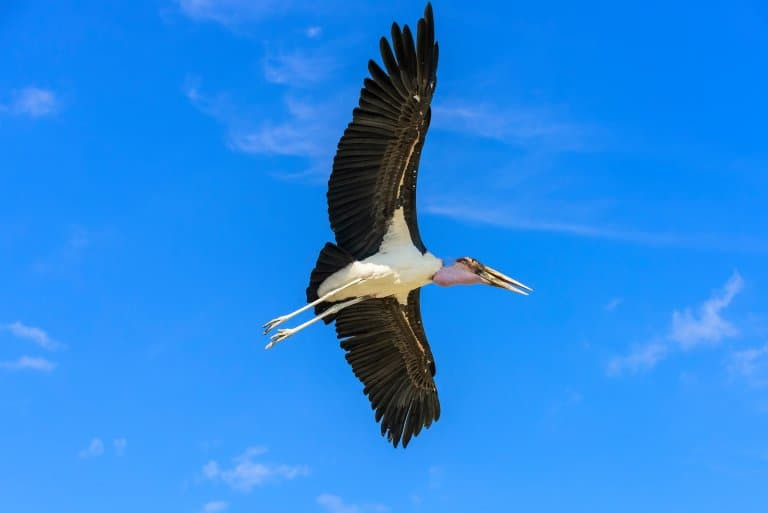 Marabou Stork Wingspan: A Scavenging Giant
Marabou Stork Wingspan: A Scavenging Giant
Claims exist of Marabou Storks reaching wingspans exceeding 3 meters, even rivaling the Andean Condor for the largest wingspan among flying birds. However, these claims currently lack robust verification. Nevertheless, the Marabou Stork is undeniably one of the largest flying birds. While perhaps lacking the aesthetic appeal of the condor with its bald head and peculiar neck appendage, the Marabou Stork possesses a unique and somewhat endearing “ugly cuteness.” Standing at 1.2 meters tall with a wingspan of 2.9 meters, the Marabou Stork (Leptoptilos crumeniferus) truly earns its place among the largest birds on Earth. [7](#easy-footnote-bottom-7-8975 “Valuska, A. J., Leighty, K. A., Schutz, P. J., Ferrie, G. M., Sky, C. C., & Bettinger, T. L. (2013), “The use of visual barriers to reduce aggression among a group of marabou storks (Leptoptilos crumeniferus)“, Zoo Biology.”)
3. Andean Condor (Wingspan: 3 m / 9.8 ft)
Weight: 16 kg / 13.2 lb
The Andean Condor typically surpasses almost every other flying animal in average weight and wingspan. This makes it, on average, the largest flying creature in existence.
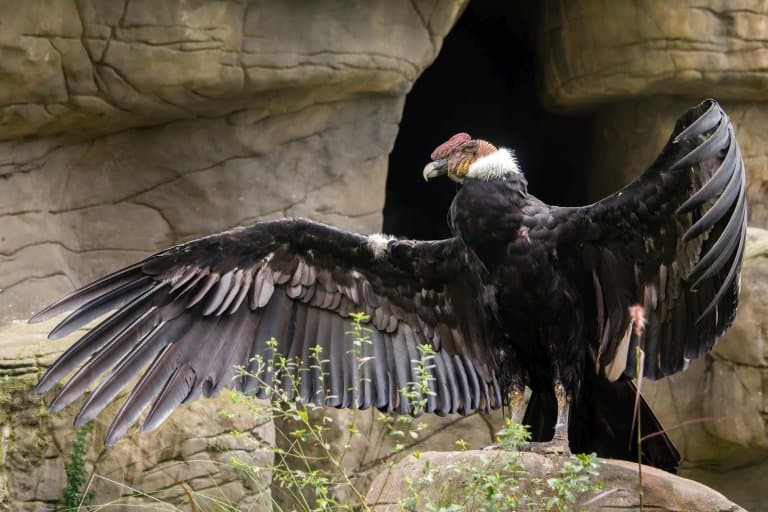 Andean Condor: The Largest Flying Bird in The Western Hemisphere
Andean Condor: The Largest Flying Bird in The Western Hemisphere
While male Kori Bustards can sometimes outweigh them, and exceptionally large individuals of the next two species can exceed the condor’s wingspan, the Andean Condor consistently holds the title of the largest flying bird on average. Their immense wing area allows them to soar for hours without flapping, conserving significant energy for such a massive bird. The Andean Condor is recognized as the largest flying bird in the Western hemisphere and globally when considering both weight and wingspan together. [8](#easy-footnote-bottom-8-8975 “Carly Cassella (2020), “These Giant Condors Can Fly For Hours Without Flapping Their Wings Even Once“, Science Alert.”)
2. Cinereous Vulture (Wingspan: 3 m / 9.8 ft)
Weight: 13 kg / 28.6 lb
The Cinereous Vulture, another impressive raptor, faces stiff competition in the “largest wingspan” category. The Himalayan Vulture boasts a very similar wingspan, making it challenging to definitively rank them. However, the Cinereous Vulture, also known as the Black Vulture, perhaps sounds more imposing, and its slightly heavier weight gives it a slight edge in this comparison.
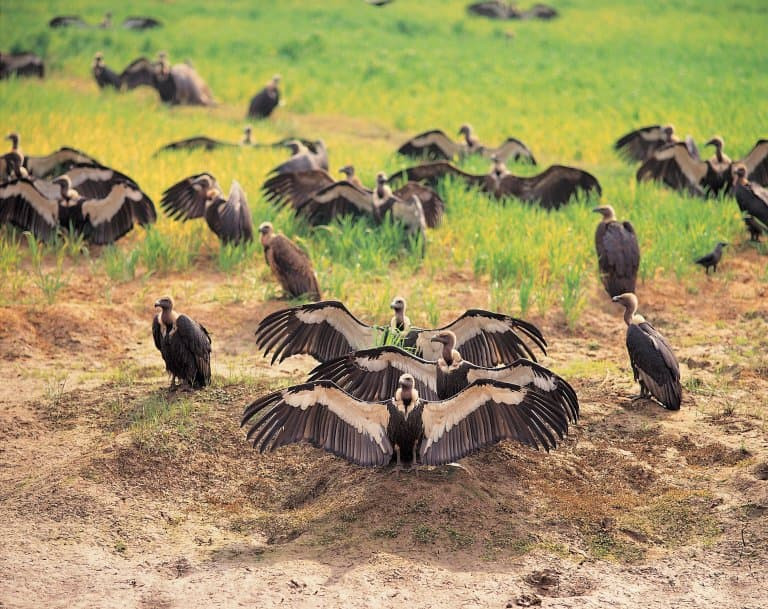 Cinereous Vulture: The Largest Old World Vulture
Cinereous Vulture: The Largest Old World Vulture
The Cinereous Vulture is the largest Old World vulture and a prominent member of the bird of prey family. This species has a wide distribution, ranging from Spain across Europe, the Middle East, and Asia. They are also known for their longevity, with some individuals living for almost 40 years. Though primarily scavengers, Cinereous Vultures have been known to occasionally prey on young livestock, demonstrating their significant size and power. They faced population declines and even extinction in parts of Western Europe due to poisoning, but reintroduction programs have achieved some success in restoring their numbers. [9](#easy-footnote-bottom-9-8975 ““Cinereous vulture“, WAZA.”)
1. Wandering Albatross (Wingspan: 3.2 m / 10.5 ft)
Weight: 12 kg / 26.4 lb
Of all the birds on this list, the Wandering Albatross arguably faces the least competition for its top spot. While other albatross species come close, the Wandering Albatross consistently demonstrates a larger wingspan, reliably measured at 3.2 meters, with credible reports reaching up to 3.5 meters.
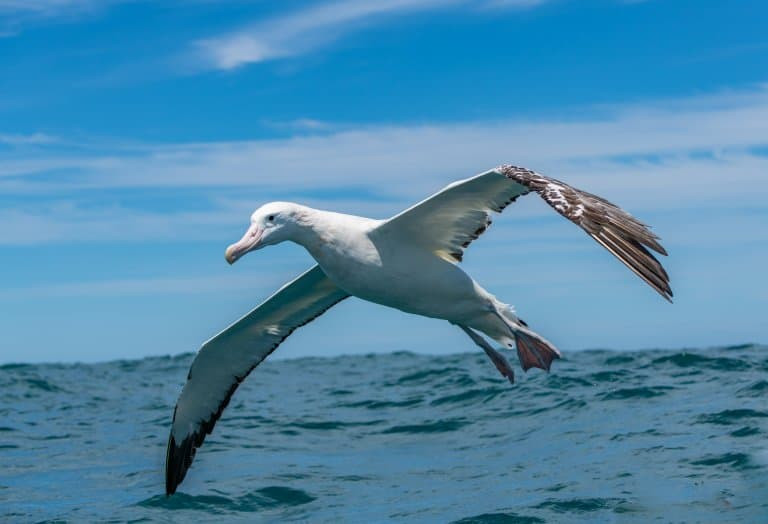 Wandering Albatross: The Bird with The Largest Wingspan
Wandering Albatross: The Bird with The Largest Wingspan
The Guinness Book of World Records even recognizes a Wandering Albatross caught in 1965 with a wingspan of 3.63 meters (almost 12 feet) as the largest wingspan ever recorded for a living bird species. These are truly long-distance champions, capable of traveling over 120,000 km (75,000 miles) in a single year and covering 900 km (560 miles) or more in a single day. Their exceptional wingspan is perfectly adapted for their lifestyle, allowing them to spend almost their entire lives in the air, only landing to eat and breed. [10](#easy-footnote-bottom-10-8975 “Pierre Jouventin & Henri Weimerskirch (1990), “Satellite tracking of Wandering albatrosses“, Nature.com.”)
Final Thoughts
This concludes our exploration of the largest flying birds in the world by wingspan that are alive today. But, does size truly matter?
For many, the sheer size of these birds is a source of fascination and awe. However, for researchers, size is a crucial, measurable metric that provides valuable insights into species conservation and the health of their environments. Measurements of size can help infer a bird’s physical, physiological, and ecological characteristics, including sex, dietary needs, energy requirements, and their role in nutrient cycling within ecosystems.
Interestingly, in most bird species, males are typically larger than females. However, in some bird families, particularly birds of prey like raptors and eagles, this size difference is reversed, with females being larger. The reasons behind this phenomenon are still being investigated, presenting an intriguing area of ongoing research. [11](#easy-footnote-bottom-11-8975 “Paul R. Ehrlich, David S. Dobkin, and Darryl Wheye (1998), “Size and Sex in Raptors“, Stanford.”)
It’s important to remember that this list focuses specifically on flying birds, excluding flightless giants like the ostrich or southern cassowary. Flightless bird species represent only a small fraction (around 1%) of all bird species. Freed from the constraints of flight, these birds often evolve to be much heavier and larger, with denser bones and reduced wingspans. In fact, the top 10 biggest birds in the world by weight are all flightless, demonstrating how the absence of flight can lead to dramatically different size and body mass characteristics.